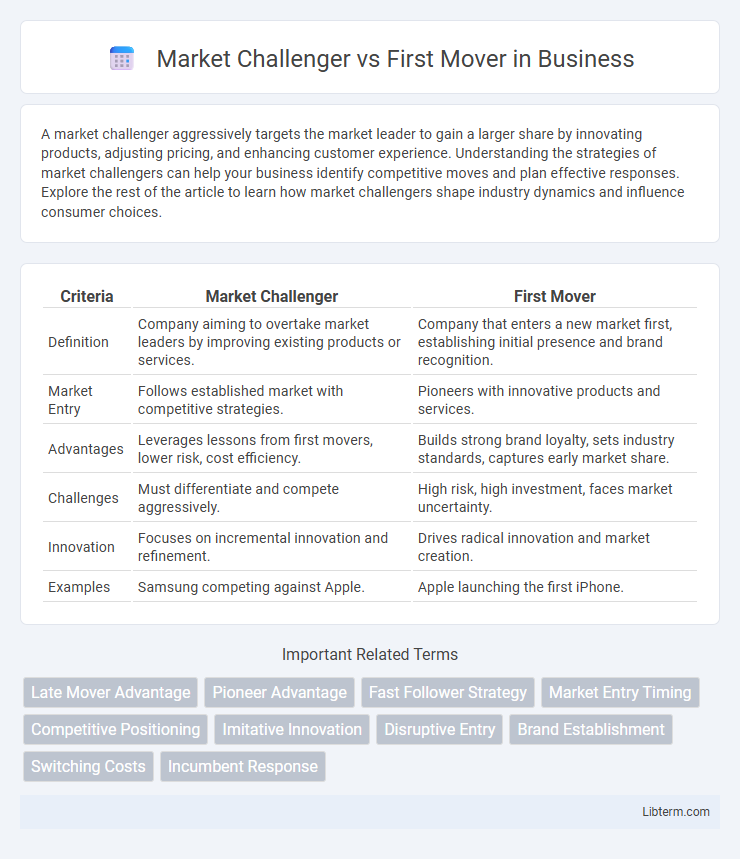A market challenger aggressively targets the market leader to gain a larger share by innovating products, adjusting pricing, and enhancing customer experience. Understanding the strategies of market challengers can help your business identify competitive moves and plan effective responses. Explore the rest of the article to learn how market challengers shape industry dynamics and influence consumer choices.
Table of Comparison
| Criteria | Market Challenger | First Mover |
|---|---|---|
| Definition | Company aiming to overtake market leaders by improving existing products or services. | Company that enters a new market first, establishing initial presence and brand recognition. |
| Market Entry | Follows established market with competitive strategies. | Pioneers with innovative products and services. |
| Advantages | Leverages lessons from first movers, lower risk, cost efficiency. | Builds strong brand loyalty, sets industry standards, captures early market share. |
| Challenges | Must differentiate and compete aggressively. | High risk, high investment, faces market uncertainty. |
| Innovation | Focuses on incremental innovation and refinement. | Drives radical innovation and market creation. |
| Examples | Samsung competing against Apple. | Apple launching the first iPhone. |
Introduction to Market Challenger and First Mover
Market challengers aggressively target the market leader by improving product features, pricing strategies, and marketing efforts to capture greater market share. First movers gain competitive advantage by entering the market early, setting industry standards, and building strong brand recognition before competitors arrive. Understanding the dynamics between market challengers and first movers is essential for strategic positioning and long-term success in competitive industries.
Defining the Market Challenger Strategy
A market challenger strategy focuses on overtaking the market leader by exploiting their weaknesses and targeting underserved customer segments. This approach emphasizes innovation, aggressive marketing, and competitive pricing to capture market share. Market challengers leverage differentiation and strategic partnerships to disrupt established market dynamics and accelerate growth.
Understanding the First Mover Advantage
First movers gain significant competitive advantages by establishing strong brand recognition and customer loyalty before competitors enter the market. Securing exclusive access to scarce resources, proprietary technology, and economies of scale further strengthens their market position. However, these benefits must be balanced against the risks of market uncertainty and high initial investment costs inherent in pioneering new products or services.
Key Differences Between Challenger and First Mover
Market challengers aggressively target established first movers by improving product features, pricing, and marketing strategies to capture market share. First movers benefit from brand recognition, customer loyalty, and the ability to set industry standards but often face higher risks and costs associated with market development. Key differences include risk tolerance, innovation drivers, and strategies for gaining competitive advantage in evolving markets.
Benefits of Being a Market Challenger
Market challengers benefit from observing first movers' successes and mistakes, allowing them to refine strategies and avoid costly errors. They leverage existing market awareness to implement improved products or services, often capturing market share through differentiation and competitive pricing. With established customer demand and proven market viability, challengers reduce entry risks and optimize resource allocation.
Risks and Rewards of First Mover Position
First Movers incur significant risks, including high research and development costs, market uncertainty, and the potential for competitors to learn from their mistakes, which may erode early advantages. However, they earn rewards such as strong brand recognition, customer loyalty, and the opportunity to set industry standards, creating high entry barriers for followers. Market challengers benefit from observing First Movers to innovate and avoid pitfalls, often gaining competitive advantages without bearing the same initial costs and risks.
Case Studies: Successful Market Challengers
Market challengers like Pepsi and Samsung demonstrate strategic innovation and aggressive marketing to disrupt first movers such as Coca-Cola and Apple. Pepsi's targeted campaigns and product diversification enabled substantial market share gains despite Coca-Cola's early presence. Samsung's rapid technology adoption and broad product range positioned it as a dominant competitor against Apple's pioneering iPhone.
Case Studies: Successful First Movers
Apple's introduction of the iPhone in 2007 transformed the smartphone market by combining innovative design with a user-friendly interface, setting a benchmark that challengers like Samsung later emulated and improved upon. Amazon's early entry into e-commerce allowed it to capture significant market share and develop a robust logistics network, forcing competitors such as Walmart to evolve their online strategies. Tesla's pioneering approach in electric vehicles established brand dominance and accelerated industry-wide adoption of sustainable technologies ahead of traditional automakers.
Choosing Between Challenger and First Mover Strategies
Choosing between a market challenger and first mover strategy depends on factors such as resource availability, risk tolerance, and competitive dynamics. First movers benefit from brand recognition and customer loyalty but face high costs and uncertainty, while challengers leverage established market data to innovate and capture market share. Strategic analysis of market timing, innovation capability, and competitor behavior guides businesses to select the optimal approach for sustainable growth.
Future Trends in Market Entry Strategies
Market challengers increasingly leverage agile innovation and data-driven insights to disrupt established first movers, capitalizing on evolving consumer preferences and digital transformation. Future trends in market entry strategies emphasize strategic alliances, rapid scalability, and adaptive business models to outpace incumbents. Embracing AI-driven market analysis and sustainability-focused products will differentiate challengers while first movers must continuously innovate to maintain competitive advantage.
Market Challenger Infographic

 libterm.com
libterm.com